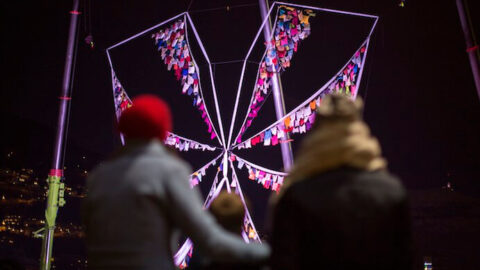From March 7-11, an international roster of eclectic performing artists descended upon Bergen, Norway for 5 days of experimental music at the 2018 Borealis Festival. Grounded in the idea of building a space to gather people, listen together, and celebrate thinking differently, Artistic Director Peter Meanwell and Managing Director Tine Rude have built a festival that prioritizes equal gender balance among the artists, which this year numbered more than 50 over 28 events in 12 different venues.
On March 9th, Meanwell sat down with Iceland’s S.L.Á.T.U.R. collective (Áki Ásgeirsson, Bergrún Snæbjörnsdóttir, and Páll Ivan frá Eiðum) to discuss the nature of the host/guest relationship. The impetus for their “Radical Hospitality” project was the question of how to broker between artists and audiences in order to present radical art while bringing down institutional barriers. Meanwell outlined some basic concepts for making experimental art accessible—start on time, don’t be rude to audiences, create easy to read programs, let the audience form their own opinions—and several performances throughout the festival exemplified this notion of accessibility through familiar narratives and public spaces.
Later in the evening on March 9th at the cozy Cornerteateret, Future Opera featured three miniature operas commissioned by Bergen National Opera. Of the three operas, En reise til Sri Lanka by Lars Skoglund particularly struck a familiar note with the audience. Based on the concept of things that go unsaid in conversation, the music and the libretto created a quirky, relatable scenario involving former lovers and perhaps soon-to-be lovers bumping into one another in a library. Through a combination of spoken word, disjunct recitative, and an angular, thin texture formed by plucked violin and guitar, Skoglund had the audience engaged and laughing at the all-too-familiar awkwardness of human interaction.

While Skoglund’s En reise til Sri Lanka was set in a library, the electrifying Bergen-based avGardEns occupied the Bergen Offentlige Bibliotek on March 10th for a free concert that staged pieces throughout the library. avGardEns presented challenging music, but the comfortable space of the public library created a familiar channel through which to access the program. Alwynne Pritchard’s site specific sound performance The mechanics of stuff began on the main level with vocal glisses and hisses while books were precariously stacked in the center of the room. As the swaying tower of books inevitably collapsed, the audience was led upstairs for works by Jostein Stalheim and Eilert Tøsse. Stalheim’s Mellomrom og strenger featured pianist Ljubov Katerli strumming the strings inside of a deconstructed upright piano and knocking on its exterior as Pritchard explored a wide spectrum of vocal timbres through vowel shaping, varied vibrato speeds, tongue clicks, and vocal fry, all with incredible control of technique. Tøsse’s Starter reisen? showcased soprano Hilde Annine Hasselberg’s pure clarity of tone in elongated consonant melodies over fractured electronic motivic samples of her live performance.

The final room of the library began with Katerli’s Miniatyr for solo piano, which starts on a single ostinato pitch, progresses through harmony to violent tone clusters, then gradually returns to its starting point. Marcus Davidson’s King of Carion and Littleblood acted as a high drama art song for voice and piano with contrasting moments of disjunct and pulsating chordal accompaniment, soaring lyrical vocal melodies, sparse delicate arpeggiation, and thick textured chromaticism. Kristin Bolstad’s Zenlight concluded the performance as both sopranos, accordion, and piano created four independent yet interwoven strands of sound. With most of the performers doubling as composers, avGardEns proved to be an elite ensemble capable of presenting experimental music in an approachable way.
On the afternoon of March 11th, Stephan Meidell’s Metrics Ensemble took the idea of moving through a familiar space to another level by giving the audience free agency to move around the performance. Presented as part of an afternoon that sought to rethink chamber music, members of the Metrics Ensemble (Meidell, electric guitar and electronics; Magda Mayas, prepared piano; Benedicte Maurseth, Hardanger fiddle; Lars Henrik Johansen, harpsichord; and Morten Barrikmo, clarinets) were staged in different rooms of the KODE 2 art gallery, and audiences were able to curate their own listening experiences by choosing their level of movement throughout the space. Though performing in separate rooms, each performer was piped in to every room, thus creating an aural scavenger hunt of sorts—some attempted to locate the genesis of each sound, while others opted to lie on the floor of the electric guitar/electronics room and absorb the hypnotic beats for an hour. The work alternated between an almost raga-like trance of driving rhythms with improvised melodic flourishes and a floating calm stillness marked by bowed electric guitar and bowed piano strings.

The festival concluded with a free outdoor performance at the Festplassen, which presented the world premiere of Natacha Diels’ opera/ballet Papillon and the Dancing Cranes for large ensemble and construction cranes (pictured above) performed by Ensemble Pamplemousse and the Pinquins percussion trio. Never did I imagine that I would one day describe construction cranes as whimsical and graceful, yet Diels’ work transformed these metal industrial giants into magical, majestic creatures. The live performance of the score for electronics and percussion provided an accompaniment of pounding bass and sparkling child-like bells for the cranes’ dance. The grand finale featured the cranes lifting a massive web of colorful fabrics in the shape of a butterfly that rippled in the breeze as children exclaimed with glee. Looking around the Festplassen, the collection of people that gathered for this closing concert perfectly exemplified the sense of community that Borealis has managed to cultivate through making experimental music accessible.
























